When you embark on a quest to find the best exercise bike, it’s easy to get distracted by bright, shiny objects — huge touchscreen! virtual rides! — while overlooking critical questions like, “How does this thing actually work?” The best magnetic exercise bikes provide a smooth, quiet ride and don’t require as much routine maintenance as those with friction-based resistance systems.
Stationary bikes that utilize magnetic and friction resistance rely on a flywheel (a heavy disc) to regulate the level of resistance you feel when you turn the pedals. While a friction system uses a brake pad to slow down the flywheel, magnetic systems use — you guessed it — magnets to do the same thing, but without the metal-on-metal connection. Check out our top picks to see which one pulls you in — ya know, like a magnet.
The 8 Best Best Magnetic Exercise Bikes for 2025
- Best Overall Magnetic Exercise Bike: NordicTrack S22i
- Best Compact Magnetic Exercise Bike: ProForm Carbon CX
- Best High-End Magnetic Exercise Bike: Echelon Connect EX-8s
- Best Magnetic Exercise Bike with Large Display: Stryde Bike
- Best Rear-Wheel Magnetic Exercise Bike: Diamondback 1260sc Rear Wheel Studio Cycle
- Best Recumbent Magnetic Exercise Bike: NordicTrack Commercial R35
- Best Folding Magnetic Exercise Bike: Exerpeutic Folding Magnetic Upright Bike
- Best Budget Magnetic Exercise Bike: Yosuda Indoor Cycling Bike
How We Tested and Chose the Best Magnetic Exercise Bikes
The BarBend team of certified personal trainers, CrossFit coaches, and cyclists have years of experience assembling, moving, repairing, and — of course — riding all kinds of exercise bikes. We tested more than 20 exercise bikes from the top brands, putting their magnetic resistance systems to the test and rating each of them on a scale from 1 (boo!) to 5 (hooray!) across 12 categories, including adjustability, durability, and value. Here are a few of the key factors we considered that can help you know what to look for when buying an indoor cycle.
Resistance Type
Most upright and recumbent bikes use one of two types of resistance systems — magnetic or friction. A friction system works a lot like the brakes in your car. As the rider adjusts the resistance, a brake pad either applies more or less friction to the flywheel, requiring more or less force to turn the pedals during a ride.
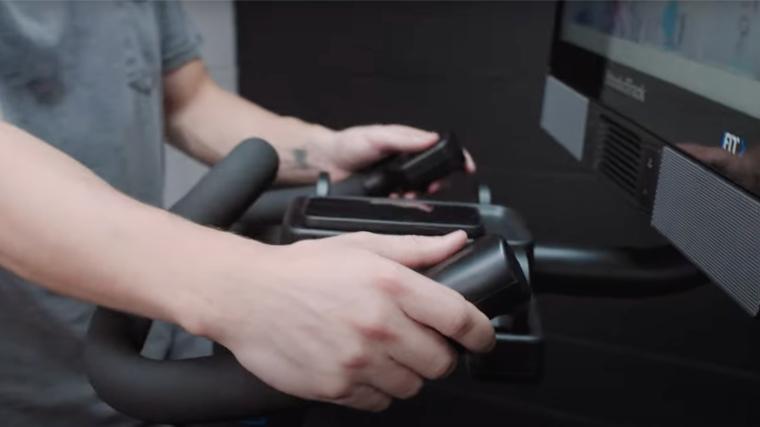
A magnetic system instead uses large magnets on both sides of the flywheel to adjust the resistance felt by the rider. When you adjust the resistance level on a magnetic system, the magnets move closer or further away from the flywheel. As the magnets get closer to the flywheel, you’ll need to pedal harder to complete a cycle. In general, magnetic systems provide a smoother, quiet ride and the bikes overall tend to be more durable than those with friction systems. All the picks in our list utilize a magnetic resistance system.
Adjustability
Whether it’s the resistance, seat, or handlebars, we made sure to include options that are highly adjustable. Most of the picks that made the cut range from 16 to 32 resistance levels, with some high-end options surpassing that average and more low-impact models falling below it. While you’re riding, the last thing you want is to be fumbling around trying to change the resistance.

Most bikes out there include the good ol’ fashioned rotating knob on the frame, but we also wanted to include more high-tech options that allow you to adjust resistance via Bluetooth controllers, digital controls, and quick-touch buttons in the grips.
Price
We also wanted to provide a wide price range — $190 to $3,079, to be precise — to accommodate as many budgets as possible. Investing in home gym essentials is a big expense for many people, so we sought to broaden the typical range of roughly $600 to $2,000 that we see across most exercise bikes. As the number of resistance levels increase, along with tech features like large touchscreens and fitness app compatibility, the price of the bike tends to increase, as well.
Best Overall Magnetic Exercise Bike: NordicTrack S22i
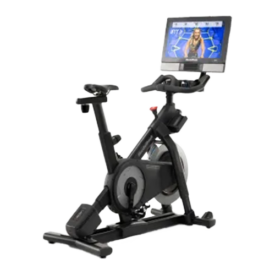
The NordicTrack Commercial S22i is high-tech and high quality, featuring both advancements like a 22” touchscreen display, and solid specs like 24 levels of quiet magnetic resistance.
Specs
- Price: $1,999
- Dimensions: 58″ H x 61″ L x 22″ W
- Resistance: 24 levels of magnetic resistance
- Display: 22” HD touchscreen
- Weight: 205lbs
- Weight Capacity: 350lbs
Pros
- Between the 24 levels of magnetic resistance, 350-pound weight capacity, and 22-inch HD touchscreen, the S22i is the total package.
- With iFIT onboard, you can take on over 17,000 live and on-demand classes, some of which can automatically adjust your resistance as you ride.
- Incline and decline capabilities are rare for any exercise bike, much less a -10- to 20-percent range.
Cons
- Access to iFIT’s library of on- and off-bike workouts requires a monthly subscription of $39.99 per month.
- The bulky 22-inch display and 205-pound overall weight can make it difficult to move it around your training space.
The NordicTrack S22i was a no-brainer as our best overall magnetic exercise bike because it packs in everything you need. With 24 levels of adjustable resistance, incline and decline capabilities (a rarity on exercise bikes), and a 350-pound weight capacity (50 pounds more than average), this bike earned at least a 4.5 out of 5 in nine out of 12 categories. One of our three testers noted how the 32-pound flywheel aids in the resistance adjustment. “Whether I did it myself or let iFIT change it hands-free, the resistance adjusted so smoothly,” they said.
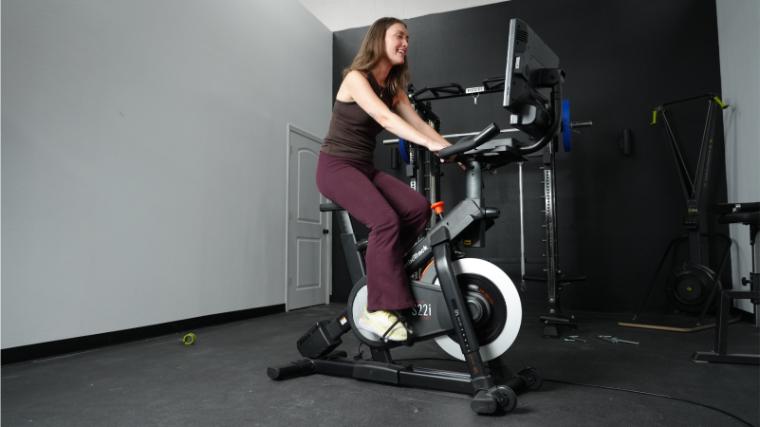
The onboard 22-inch HD touchscreen brings these workouts to life and, as BarBend’s expert product tester Jake Herod, NASM-CNC, pointed out, “The touchscreen monitors tilts, but also rotates 360 degrees so you can hop off and do some strength training or join a yoga class.” Along with breaking down the features that make this bike stand out, he also described his experience using the S22i in his video review below.
Any incline or decline capability on an exercise bike is a rare inclusion, which made the S22i’s -10-percent to 20-percent range that much more impressive to BarBend editorial member and certified personal trainer, Kate Meier. “Having decline and incline really made it feel like I was riding along those Hawaiian cliffs,” she said. Accessing the integrated iFIT programming requires a monthly subscription — $39.99 per month — but earned a rating of 5 out of 5 from Meier.
When she tried moving the NordicTrack S22i around her space, though, Meier discovered a downside of that large screen. “I had to be careful to let the screen knock into things when I moved it around,” she described. “There isn’t really a good place to grab, like a built-in handle, so some people would probably need a hand to relocate it.” At 205 pounds, it’s a full 70 pounds heavier than the other upright bikes on our list, which earned it a 3.5 out of 5 from Meier.
Read our full NordicTrack S22i Exercise Bike Review.
Best Compact Magnetic Exercise Bike: ProForm Carbon CX
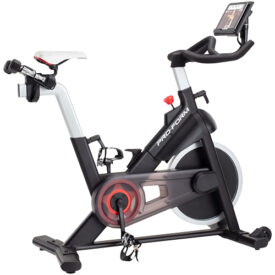
The ProForm Carbon CX is a sturdy steel 125-pound build with 16 levels of silent magnetic resistance. In addition to being one of the quietest options on the market, this bike also comes with a free year of iFit and a swiveling tablet holder, so you can stream classes on and off the bike.
Specs
- Price: $399
- Dimensions: 51″ H x 52.5″ L x 21.9″ W
- Resistance: 16 levels of magnetic resistance
- Display: 180-degree swiveling tablet holder
- Weight: 125lbs
- Weight Capacity: 250lbs
Pros
- With a footprint of 7.98 square feet, it’s the most compact bike featuring iFIT integration we have tested.
- During select iFIT classes, the 16 levels of magnetic resistance can be automatically adjusted during your ride.
- By using your own device in the swiveling tablet holder, you’ll save up to $450 compared to the average bike with iFIT compatibility.
Cons
- Since there is no integrated screen, you’ll need to use your own device to stream workouts or entertainment.
- This bike is short on conveniences like speakers, fans, or heart rate sensors.
Taking up just 7.98 square feet, the ProForm Carbon CX is the most compact bike we’ve tested that also features iFIT integration. At just $399, it’s also one of the most affordable bikes with iFIT by up to $450. That’s due in part to its lack of a built-in touchscreen, meaning you’ll have to sync your own mobile device via the bike’s Bluetooth connectivity to access the app’s vast library of cardio, strength, and mobility classes, as well as its SmartAdjust technology.
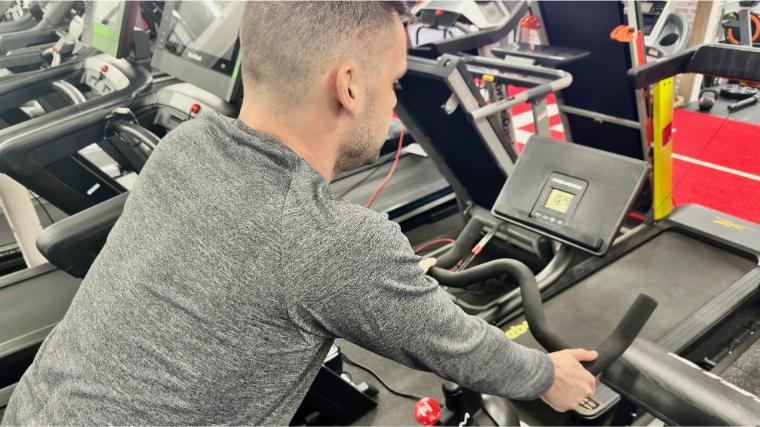
When I had the chance to saddle up on the Carbon CX, I scored seven out of 12 categories a 4 out of 5 or higher, including a 4.5 for its footprint and portability. At 125 pounds, I thought the transport wheels made it easy to move around, although I can see how on thick carpets you may meet stiffer resistance than on our gym flooring.
[Related: The 9 Best Portable Exercise Bikes]
Speaking of resistance, the magnetic system on the Carbon CX allows for 16 levels of resistance. You can adjust it via a knob beneath the handlebars, but I found myself preferring the plus and minus buttons on the console.
Taking into consideration the four-way adjustable seat and adjustable handlebars, I scored its adjustability 5 out of 5. Even at 6 foot 3 inches, our tallest tester — a certified personal trainer and nutrition coach — noted how it helped them find a comfortable fit.
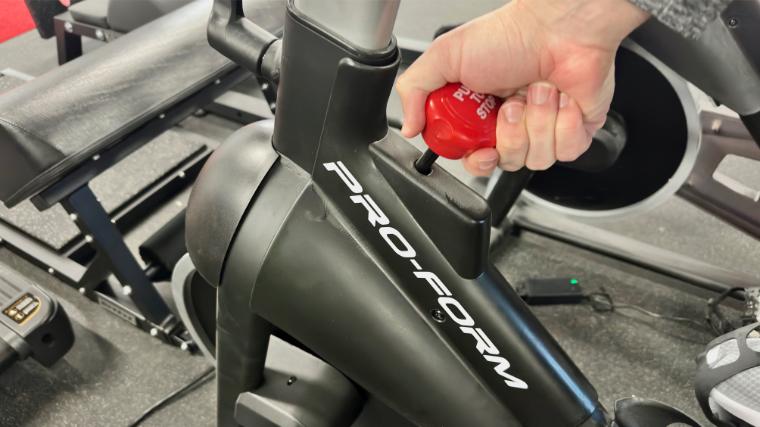
“I usually max out the ranges on seats and handlebars, but adjusting everything to find my fit was no problem,” they explained. “It’s also pretty crazy for such an affordable bike to have the auto-adjusting resistance feature.”
While the three-pound dumbbells can provide a full-body workout, you won’t find many conveniences. The Carbon CX has no heart rate monitor, water bottle holder, or built-in speaker. After taking it for a spin, I didn’t find myself missing them, though, especially since the resistance was quiet enough for me to hear the audio from my iPad’s speakers.
Read our full ProForm Carbon CX Exercise Bike Review.
Best High-End Magnetic Exercise Bike: Echelon Connect EX-8s
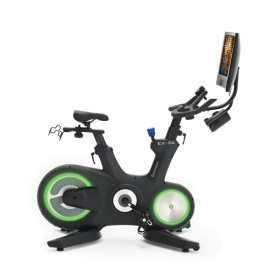
The Echelon EX-8s can glam up your home gym with a dual-flywheel design outfitted with LEDs you can customize by color, tempo, and brightness. The 24-inch touchscreen is curved to offer a deeper sense of immersion during classes on the Echelon Fit app.
Specs
- Price: $3,079.99
- Dimensions: 65’’ H x 59’’ L x 23’’ W
- Resistance: 32 levels of magnetic resistance
- Display: 24” curved HD touchscreen
- Weight: 124lbs
- Weight Capacity: 300lbs
Pros
- Between the curved 24-inch touchscreen, dual front-facing Bluetooth speakers, and customizable LED flywheel lights, the EX-8s is the epitome of high-end.
- Use the Bluetooth controller on the handlebars, digital settings on the screen, or good ol’ fashioned knob to adjust its 32 levels of magnetic resistance.
- With Echelon Fit built-in, you can stream over 15,000 live and on-demand rides, HIIT sessions, or yoga classes on or off the bike.
- Its shock absorption system can help reduce the impact on joints when you rise out of the saddle.
Cons
- Its $3,079 price tag makes it roughly $1,600 more than the Peloton Bike.
- Our tester noted the bulky screen can wobble a bit during intense rides or when you move it around.
- Some of its high-tech features, like the pulsating LED lights may be a bit extra for some.
The Echelon Connect EX-8s delivers a luxury indoor cycling experience. What first caught our eyes on this high-end bike were the pulsating LEDs built into the dual-flywheel design. These customizable lights flash and change color to match your heart rate and other metrics, creating as close to a studio experience as you can get in your living room. Studio classes unfold on a huge 24-inch touchscreen, which has a curved design that studies have shown can produce a more immersive viewing experience. (1)(2)
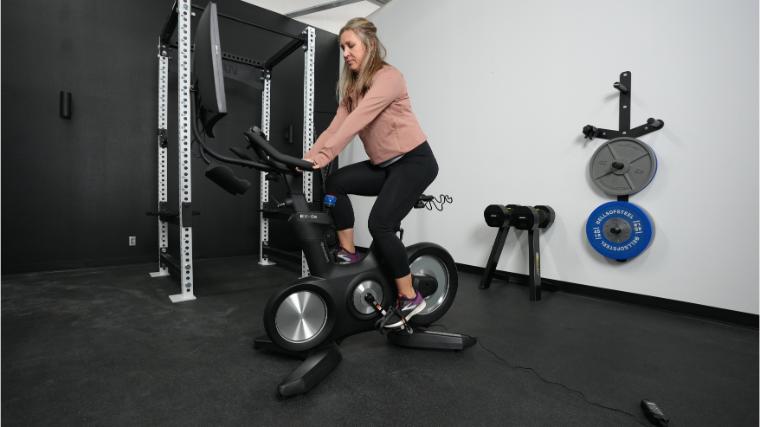
Five out of 12 categories earned a 4 out of 5 or higher from our tester, a CrossFit Level 1 trainer, including customizations and adjustability. When you need to switch between its 32 resistance levels, you can either jump to a specific level on the screen, turn the dial on the frame, or use the Bluetooth controls on the handlebar when you’re out of the saddle.
[Related: The 8 Best Exercise Bikes with Screens]
There are over 15,000 workouts available via the integrated Echelon Fit app — with a $39.99 per month subscription — but they felt the programming wasn’t quite ready to compete with Peloton. “I think the classes are good, and you can tell they’re still building it out, but it’s not on Peloton’s level yet,” they said, rating the app’s programming 4 out of 5.
One unique feature we haven’t seen elsewhere is its shock absorption system, which works to reduce the impact on your joints. If you can imagine how the shocks on even a beginner mountain bike can provide a bit of bounce to absorb impact, the frame of the EX-8s has a similar feel. We felt it most when rising out of the saddle for a sprint or hill climb, so anyone with joint issues or who is recovering from an injury may appreciate the extra support.
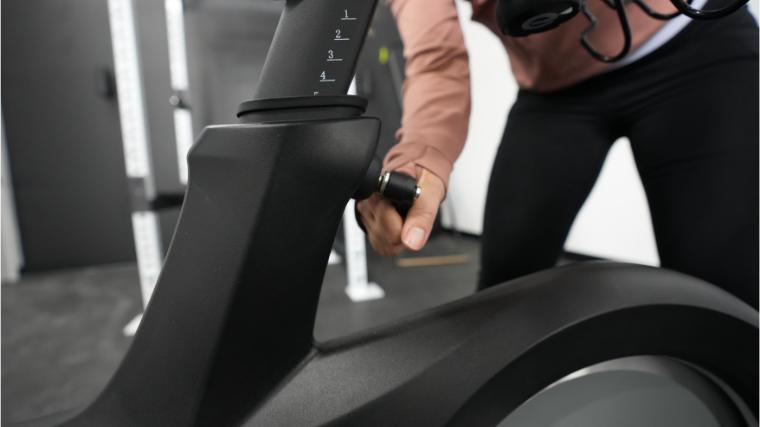
Those who like to party as they sweat may like the customizable flywheel LEDs, but our tester, despite rating this smart bike’s tech capabilities a 5 out of 5, wasn’t sure they justify the $3,079 price tag. “Obviously it’s pretty cool to have the lights synced up with your heart rate, but they’re ultimately unnecessary and you can find this bike’s fitness app integration and 32 levels of resistance for less,” they noted.
Read our full Echelon Connect EX-8s Exercise Bike Review.
Best Magnetic Exercise Bike with Large Display: Stryde Bike
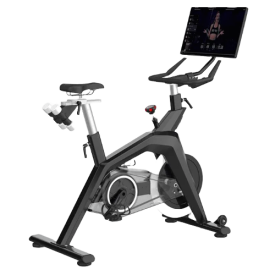
The Stryde Bike's 21-inch HD touchscreen is “unlocked,” so you’re not tied to a particular subscription service. It has 100 levels of magnetic resistance and you can use the Stryde app for $29.99 per month, but it is not required to use the bike.
Specs
- Price: $1,895
- Dimensions: 48” L x 24” W
- Resistance: 100 levels of magnetic resistance
- Display: 21” HD touchscreen
- Weight: 135lbs
- Weight Capacity: 350lbs
Pros
- Since its 21-inch HD touchscreen is “unlocked,” you can download the best fitness apps and streamers like Netflix, as you would on any phone or tablet.
- You can adjust the 100 levels of magnetic resistance manually or in micro-increments via the display.
- While Stryde’s own app is cheaper than alternatives like iFIT or Peloton, a subscription is not required to use the bike.
- Instead of producing their own classes, the Stryde app adds 50 new classes per month from top boutique studios around the country.
Cons
- For some, $1,895 may be too steep for the freedom provided by the “unlocked” screen.
- Our tester felt the Stryde app was less engaging than apps like Peloton.
Although we have seen touchscreens a few inches larger than the Stryde Bike’s, this is the only one we’ve used with an “unlocked” display. This game-changing feature made it an easy pick for the best magnetic bike with a large screen. Bikes from NordicTrack and Peloton tend to lock you into using their apps by requiring a subscription to do more than a manual ride. However, the 21-inch HD touchscreen here acts like an Android tablet, allowing you to download fitness apps (including Peloton, Zwift, and JRNY) or streamers like Netflix and Amazon Prime.
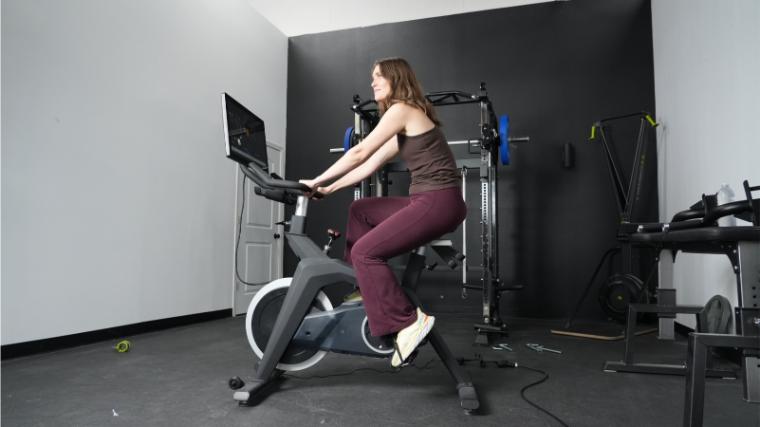
This freedom was a huge plus for our tester, who appreciated the ability to download streamers. “For anyone who’s going to use a bike for daily workout classes, this is the way to go,” they said. “The display is basically a huge Android tablet, so if you could download an app on Android, you can probably download it here.”
Nine categories earned at least a 3.5 out of 5 from our tester, a certified personal trainer, including its adjustability and customizations. You can adjust its 100 levels of resistance via the knob on the frame or by tapping the 21-inch HD display. Whether you want to steadily increase the resistance for an endurance workout or quickly jump to a specific level during a HIIT or interval session, the large display on the Stryde has you covered.
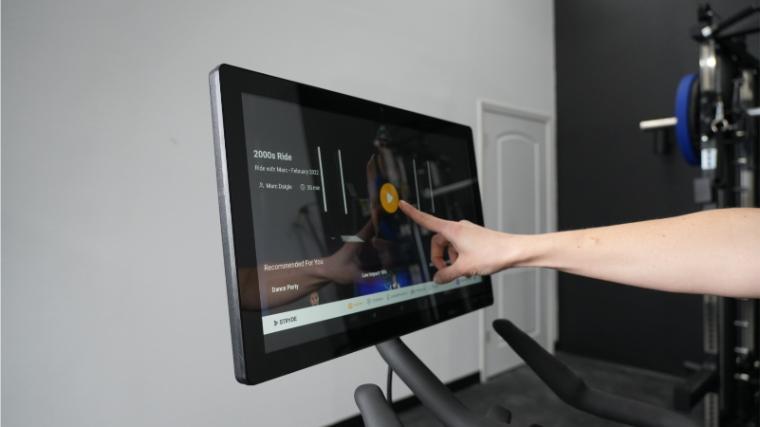
With access to top boutique studios and 50 new classes coming in every month, the Stryde app is unique compared with stalwarts like iFIT and Peloton who produce all their own content. However, with the ability to access these more established options, our tester didn’t see much use for it.
“In terms of production quality, it’s just not close to Peloton,” they said. “Especially since you get essentially any app you want, you’re probably better off skipping theirs.”
Best Rear-Wheel Magnetic Exercise Bike: Diamondback 1260sc Rear Wheel Studio Cycle
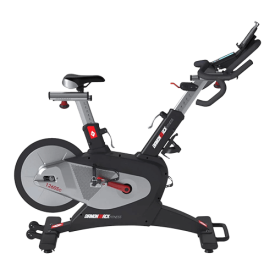
With a rear-mounted 31-pound flywheel, it can help avoid corrosion brought on by moisture from sweat or drinks. The adjustment lever for the 16 levels of magnetic resistance can allow for smooth adjustment and its user-powered design requires no electricity.
Specs
- Price: $999
- Dimensions: 50″ H x 59″ L x 23″ W
- Resistance: 16 levels of lever-adjusted magnetic resistance
- Display: LCD screen
- Weight: 130lbs
- Weight Capacity: 300lbs
Pros
- Because the 31-pound flywheel is rear-mounted — away from the rider — it can help avoid corrosion brought on by moisture from sweat or drinks.
- Our tester thought that the adjustment lever for the 16 levels of magnetic resistance provided a smoother change than a traditional knob.
- Its user-powered design requires no electricity.
Cons
- $1,500 may be a bit pricey for an exercise bike with no screen.
- The clicking noise when adjusting the resistance may be distracting for some athletes.
The 31-pound flywheel on the user-powered Diamondback 1260sc sits behind the rider, safely away from your flying sweat droplets — sorry for the visual — and condensation from water bottles. Many cycling studios use rear-wheel bikes for that reason — avoiding moisture helps stave off the corrosion brought on by contact with moisture. As such, bikes with rear flywheels tend to require less maintenance over time.
Instead of a traditional knob to adjust your resistance, the Diamondback 1260sc uses a unique lever to change between its 16 levels. Our tester called out this lever and its rear-wheel design when they rated eight of 12 categories a 4 out of 5 or higher, including its durability, adjustability, and ergonomics.
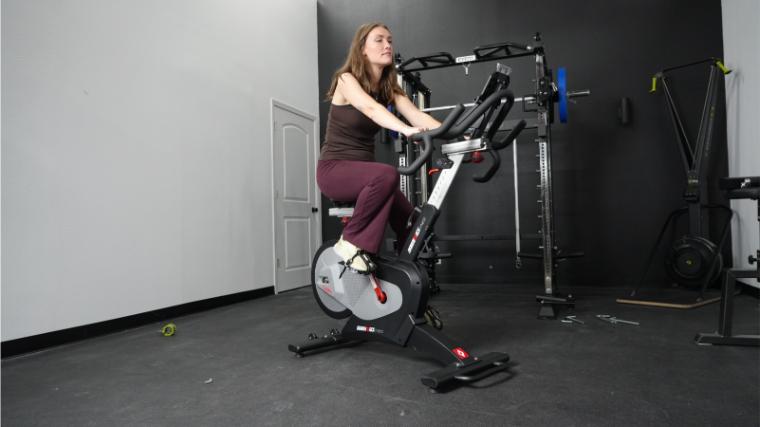
“As a bit of an exercise bike purist, I was surprised how much I liked the lever compared to a traditional dial,” our tester admitted, rating its adjustability 5 out of 5. While the clicking sound from the adjustment lever mechanism may be a nuisance for some, our tester loved it.
Some resistance knobs rely on the user to make adjustments based on feel, so they felt the clicking lever was a great way to keep them aware of their current level.“This is a totally small, but satisfying aspect of this bike. There was just something about hearing the click that let me know I was leveling up, but I also thought it made it easier to keep track of which level I was actually on,” they said.
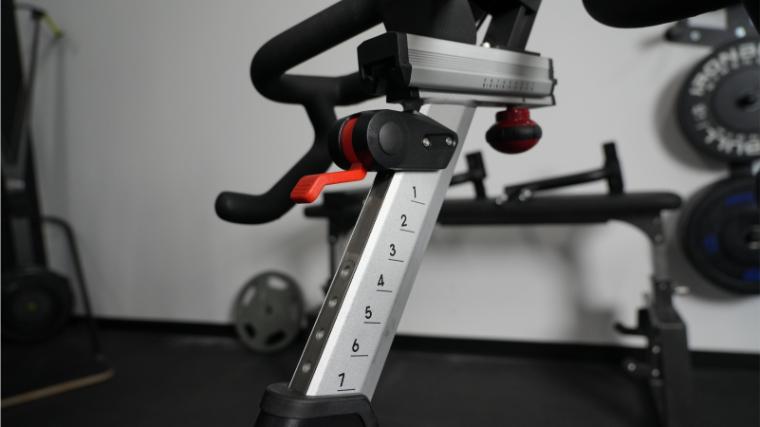
Between the design and powder-coated steel frame, its durability also earned a 5 out of 5 from our tester. “Having a 31-pound flywheel can make for a super smooth ride,” they explained.
They also noted that, while $1,500 may be steep for a bike without a screen, not having to plug it in allowed for extra flexibility in where they set it up. “Since I wasn’t tethered to a wall outlet, I could roll it in and out of the garage or into the living room to watch TV,” they said.
Read our full Diamondback 1260sc Review.
Best Recumbent Magnetic Exercise Bike: NordicTrack Commercial R35
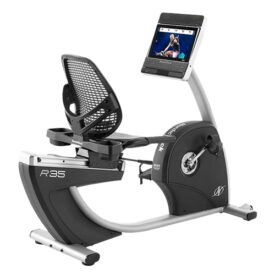
This recumbent bike features a 25-pound flywheel and 26 levels of magnetic resistance. With your purchase, you'll receive a 30-day trial to iFit, granting you access to over 16,000 workout classes ranging from cardio to strength training.
Specs
- Price: $1,499
- Dimensions: 53.42” H x 68.22” L x 23.69” W
- Resistance: 26 levels of magnetic resistance
- Display: 14” HD touchscreen
- Weight: 192lbs (in-box)
- Weight Capacity: 350lbs
Pros
- The reclined position of recumbent bikes allow for those with achy backs and joint pain to reap the benefits of cardio.
- You can adjust the 26 levels of magnetic resistance using the buttons in the right-side handrail.
- iFIT classes are available via the 14-inch HD touchscreen.
- The 350-pound weight capacity is at the high end of the average range for recumbent bikes.
Cons
- Without built-in handles, the curved design and 192-pound overall weight make it difficult to move around.
- After your included 30-day free iFIT trial, a monthly subscription costs $39.99 per month.
If you’re debating the merits of recumbent bikes vs. upright bikes, the NordicTrack R35 makes a compelling case for the former. Recumbent bikes are ideal for older users, those recovering from injury, or anyone just starting regular cardio exercise. Because their upright seats support the user’s body weight — much like a chair — there is less stress on joints and the lower back. (3)(4)
When she assessed recumbent bikes for BarBend, expert reviewer Amanda Capritto, CPT, CF-L1, CES, CSNC, laid out exactly who can benefit from this type of exercise bike. “Recumbent bikes open up the cycling experience to more people, particularly those with back, hip, or knee issues. The reclined position reduces stress on the lumbar spine and does not require as much flexibility in the hip joints.”
The 26 levels of magnetic resistance — more than the typical recumbent bike — are powered by a 25-pound flywheel, and can be controlled via easy-to-access buttons on the handrail. Eight of the 12 categories we rated in our testing earned at least a 4 out of 5, including durability, adjustability, and dynamic programming.
[Related: Best Recumbent Bikes]
The R35’s 350-pound weight capacity scrapes the top end the average weight capacity for recumbent bikes — 300 to 350 pounds — with a frame that weighs nearly 200 pounds. When they tried to move it around our gym, our tester, a certified personal trainer, struggled to get a good grip. “There aren’t any handles and the curved design made it tough to grab anywhere,” they said, rating its portability a 3.75 out of 5.
Accessing iFIT programming on the 14-inch HD touchscreen is a stand-out feature on the R35, but it does require a subscription — $39.99 per month — to access its scenic rides and studio spin classes.
While our tester highlighted its iFIT-dependent tech capabilities — like building their own routes with Google Maps, they said that a membership was more or less required to get the most out of the bike. “Without an iFIT subscription, most people would probably be better off with a more affordable option.”
Read our Full NordicTrack Commercial R35 Exercise Bike Review.
Best Folding Magnetic Exercise Bike: Exerpeutic Folding Magnetic Upright Bike
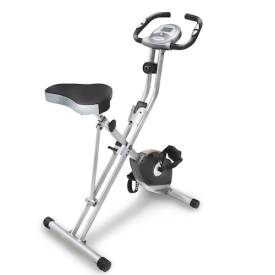
If you're tight on space or budget, this compact exercise bike is for you. It's a no frills piece of cardio equipment, but can still provide a solid indoor cycling workout.
Specs
- Price: $190
- Dimensions: Unfolded: 46″ H x 31″ L x 19″ W; Folded: 55.5″ H x 20″ L x 22″ W
- Resistance: 8 levels of magnetic resistance
- Display: LCD screen
- Weight: 39lbs
- Weight Capacity: 300lbs
Pros
- Its folding capability allows its footprint to shrink roughly 25 percent — 4.09 square feet in use to 3.06 square feet when folded.
- With just a 39-pound overall weight, most people will be able to use the transport wheels to move and store this bike by themselves.
- Its 8 levels of magnetic resistance are adjustable using the resistance knob. At just $190, it’s one of the best exercise bikes under $500 that we’ve tested.
Cons
- With just eight levels of resistance, this bike is more geared toward casual exercise than serious training.
- The seat cannot be adjusted or swapped out.
The Exerpeutic Folding Magnetic Upright Bike occupies just 4.09 square feet of floor space during use, but that footprint shrinks even further when you fold it up — down to 3.06 square feet. As one of the best folding magnetic exercise bikes we’ve tested, it can be easily folded, rolled, and stowed away. Perhaps unsurprisingly, its portability earned a rating of 5 out of 5 from certified personal trainer Kate Meier, who used the transport wheels to roll it from room to room like a hand truck.
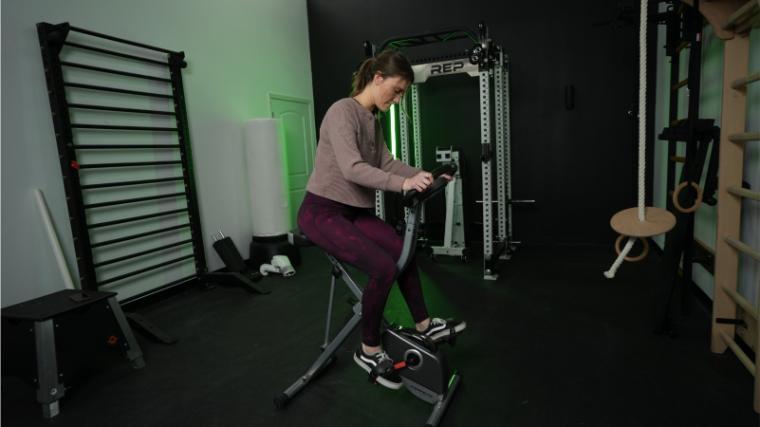
Meier also rated this bike 5 out of 5 in four out of 12 categories, including footprint (duh), setup (duh), and durability (huh?). To her surprise, this lightweight option boasts the same weight capacity as much larger and more expensive bikes, like the Echelon Connect EX-8s or Diamondback 1260sc. “It can fold up like a suitcase and be stashed in a closet, but it still supports 300 pounds,” she said.
[Related: The 6 Best Folding Exercise Bikes]
Even with its compact, foldable design, it still employs a magnetic resistance system. Meier said that, while eight levels may be short of the average range of 16 to 32 levels, for $190 its value is a 5 out of 5. “For being a no-frills, budget option, eight resistance levels is not bad,” she said. “It was enough to add a bit of a challenge to my rides.”
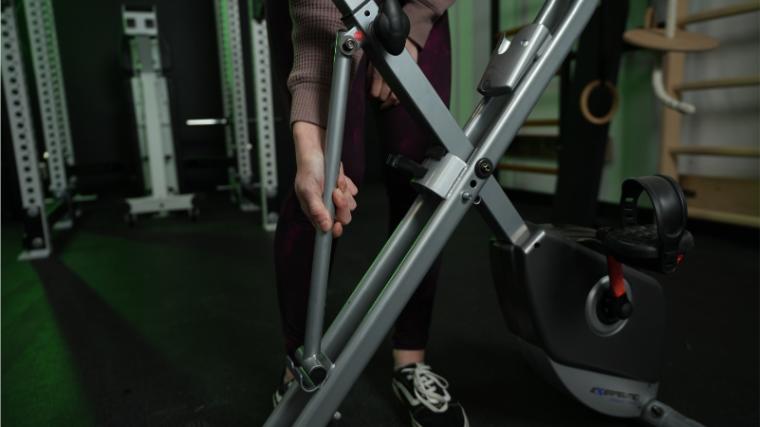
The Exerpeutic Folding Magnetic Upright Bike lacks the technology to hold up against the NordicTrack’s and Peloton’s of the world, but it can still get your heart pumping while watching TV or finding the end of your Insta feed. Meier rated its tech capabilities a 3.5 out of 5, noting that it still features an LCD screen to track your stats like speed, distance, and heart rate, which is monitored using the sensors in the handlebars.
With such a low price point, it would be unwise to expect a studio-quality experience, but for a foldable option, Meier thinks it can provide a comfortable ride. “The seat can’t be swapped out, but it is large and in charge — super cushioned.”
Best Budget Magnetic Exercise Bike: Yosuda YB001R Magnetic Exercise Bike
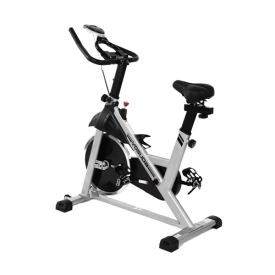
Smooth and quiet cycling with a 35 lb flywheel and attached transport wheels so you can cruise where you want to. Simple LCD screen with a lip for an iPad, tablet, or phone.
Specs
- Price: $279
- Dimensions: 45” H x 40” L x 22” W
- Resistance: Magnetic
- Display: LCD screen
- Weight: 68lbs
- Weight Capacity: 270lbs
Pros
- At $279, the YB001R is on the low end of the $190 to $699 range for budget exercise bikes.
- Its heavy 35-pound flywheel allows for smooth resistance adjustments.
- The footprint of 6.11 square feet is almost one full square foot less than the 7 to 8.5 average.
Cons
- Without labeled levels of resistance, the intensity needs to be adjusted based on feel.
- After just a few rides, our tester noticed some small tears in the seat cushion.
Coming in at the low end of the $190 to $699 average range for budget exercise bikes we’ve tested, the Yosuda YB001R Magnetic Exercise Bike boasts a heavier-than-average 35 pound flywheel. Our tester put its flywheel weight in context when they tried it out, saying, “Typically, a 15- or 20-pound flywheel would get the job done, so 35 pounds? More than enough for a smooth ride.”
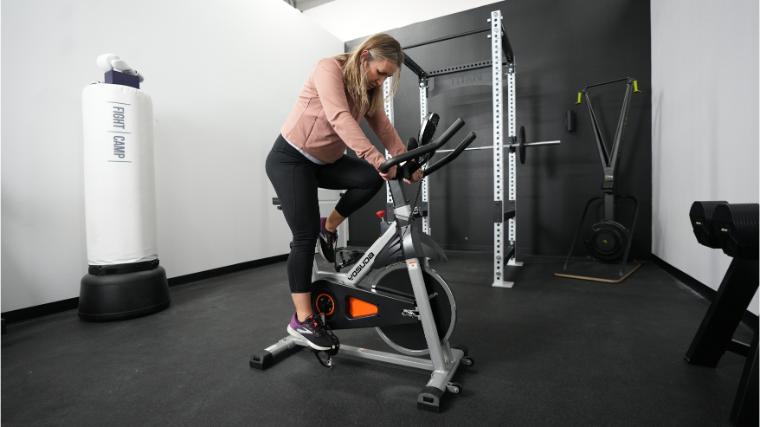
That 35-pound flywheel is actually three pounds heavier than the flywheels on some high-end bikes we’ve tested, like the NordicTrack S22i and ProForm Studio Bike Pro 22, both of which have 32-pound flywheels. Heavy flywheels provide the stability to let the user seamlessly increase or decrease the resistance, while requiring less regular maintenance. Because the levels on the YB001R are not labeled, it may take a few rides to get a good feel for your preferred resistance range.
[Related: The 12 Best Budget Home Gym Equipment of 2025]
The weight of the flywheel is even more impressive given its 68-pound overall weight — roughly 60 to 80 pounds less than the average exercise bike we have tested. And with a footprint of just 6.11 square feet and a pair of transport wheels, it is also among the most portable we’ve tried out.
In fact, our tester — a certified personal trainer and nutrition coach — gave it a 4 out of 5 in three categories, including its footprint and portability. “Super compact and it was so easy to move around the gym,” they said.
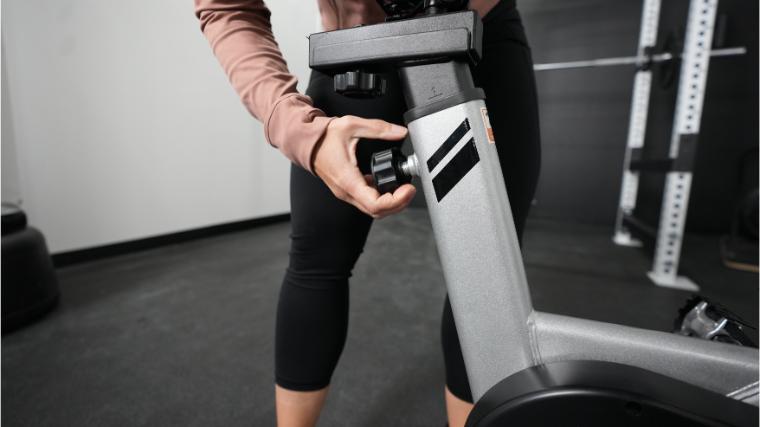
While they pointed out that at under $300, the Yosuda YB001R is a good deal, they did note that they wouldn’t count on it being their grandkids’ exercise bike. “I don’t really see it holding up more than a year or two,” they explained. “It’s probably not a forever bike, but would be good as a quick fix.”
After just a couple rides, our tester had a few concerns. “I rated its durability 2.5 out of 5 because I noticed the seat started fraying after my first few rides and the LCD screen felt it could fall off at any moment,” they pointed out.
Read our full Yosuda Exercise Bike Review.
Benefits of the Best Magnetic Exercise Bikes
Compared to a friction resistance system, bikes that utilize magnetic systems tend to provide quieter rides and smoother adjustments. They can also be a bit more durable, as brake pads in friction systems can wear out, requiring more maintenance over the long haul. Here are a few of the benefits of choosing a magnetic exercise bike.
Quiet Ride
Magnetic resistance can be much quieter than friction-based systems. When you adjust the resistance on a magnetic exercise bike, the magnets on both sides of the flywheel move closer, which requires you to apply more force to spin the pedals. Because the magnets and flywheel never come in contact, there isn’t much happening that would cause noise — apart from your huffing and puffing. (5)
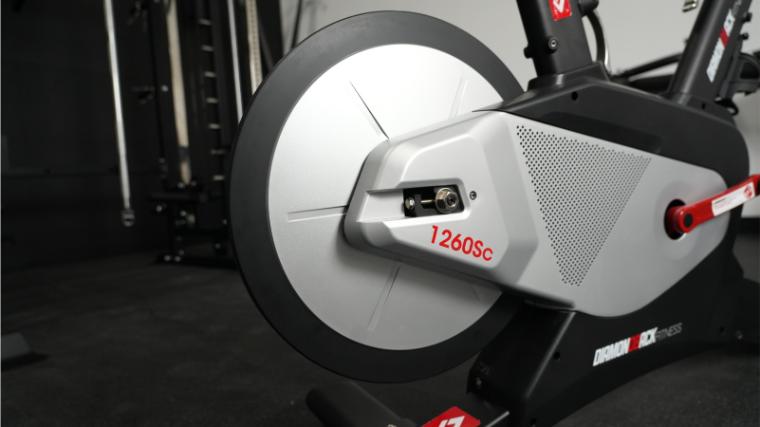
A friction system, on the other hand, uses a brake pad to physically slow down the flywheel, similar to the brakes in your car. As the resistance level increases, that pad applies more pressure, it creates more friction between the pad and the flywheel — and between you and your neighbors — and that vibration can be noisy. (5) If you’re looking for a quieter ride, we think a magnetic system is the way to go.
Durability
Generally speaking, spin bikes that use friction resistance systems require more maintenance due to the fact that the flywheel comes into contact with the brake pad. (5) These pads need to be routinely replaced as they wear down to ensure they can apply the right amount of pressure — just like your car’s brake pads. Since there is no contact between the magnets and flywheel on an exercise bike that uses magnetic resistance, there is far less wear and tear and regular maintenance.
Exercise Whenever
Owning your own exercise bike can be a convenient way to reap the benefits of cycling, regardless of weather, crowded bike paths, or busy gyms. If you spring for a magnetic bike with a screen or device holder, you can also take advantage of virtual scenic rides or live classes with the Peloton app or iFIT.
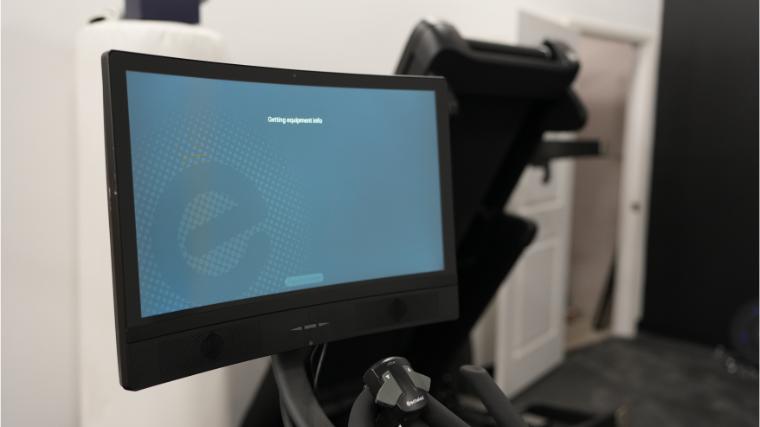
Having to walk a few feet over to your own exercise bike can be a much easier task than buying and maintaining a road bike, not to mention finding suitable routes. Owning your own machine can remove one of the major hurdles to consistent cardio exercise (talking to myself here) — convenience.
What to Consider Before Buying a Magnetic Exercise Bike
Setting air bikes aside for a moment, exercise bikes typically rely on magnetic or friction resistance. It’s important to consider how each may hold up over time, as well as the ease of adjustment they can provide during a ride. These are a few considerations to make before you break open your piggy bank.
Your Fitness Goals
Before hopping on a magnetic exercise bike, make sure to consider the kind of training you plan to take on. Bikes with magnetic or friction resistance systems can suit a range of fitness goals, from endurance to HIIT to LISS training. However, if you’re interested in CrossFit, the short, intense bursts offered by an air bike might be more up your alley. (6)(7)
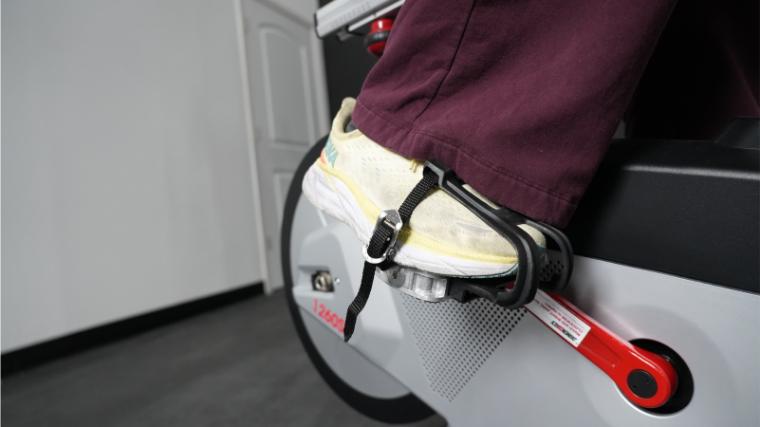
As our expert reviewer, Amanda Capritto, CPT, CF-L1, CES, CSNC, laid out for BarBend, the best air bikes are geared towards those engaging in cross-training. “People looking to build out a CrossFit-style home gym are a good fit for an air bike,” Capritto says. “Additionally, those who are generally interested in functional fitness protocols will probably get a lot of use out of one.”
Budget
Another consideration is how much you can afford to drop on your new bike. Before worrying about features or specs, set your budget in stone. As the average upright exercise bike can run you anywhere from $600 to $2,000, narrowing your search can be much easier once you take a look at your financial situation and decide just how much you can spend.
With budget-friendly options, you’re more likely to miss out on tech capabilities like an HD touchscreen or fitness app integration. You’re also likely to have fewer resistance levels on a budget option — usually between eight and 16 — whereas high-end options can have up to 100 levels of magnetic resistance.
Adjustability
Outside of the resistance levels on your bike, make sure you check just how adjustable the seat, handlebars, displays, or toe cage pedals may be. While most exercise bikes can accommodate heights of roughly 5 feet to 6 feet 3 inches, taller users may need to double check the range for the seat or handlebars. Another adjustable feature we see on high-end models are swiveling or rotating screens that allow you to follow off-bike home workouts like strength training or yoga classes.
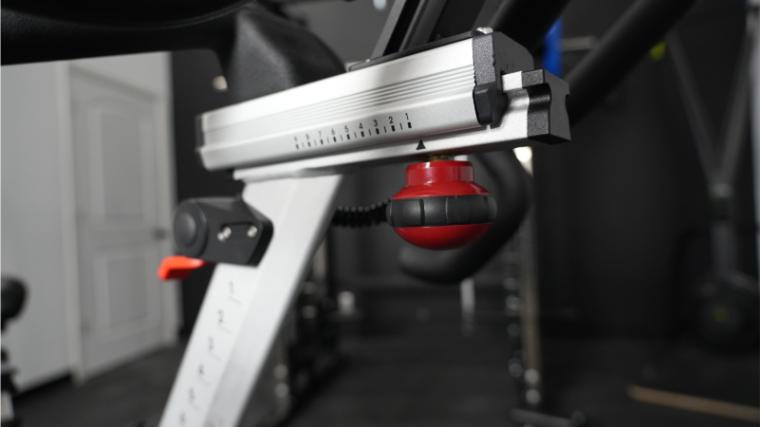
The way that you actually adjust the resistance might be a factor, as well. All the bikes we included use the standard adjustment knob on the frame, but some can also be adjusted digitally from their screen or using buttons on the handlebars. If you think it might be a bit cumbersome to reach down to spin the dial during a ride, check out another adjustment mechanism.
How Much Do the Best Magnetic Exercise Bikes Cost?
Compared with friction resistance systems, bikes with magnetic systems tend to cost slightly more. There are, however, quality options as low as $190. Check out the wide range of options we included on our list to get a sense of just how much coin you’ll need to drop on your bike.
| Best Overall Magnetic Exercise Bike | NordicTrack S22i | $1,999 |
| Best Compact Magnetic Exercise Bike | ProForm Carbon CX | $399 |
| Best High-End Magnetic Exercise Bike | Echelon Connect EX-8s Exercise Bike | $3,079 |
| Best Magnetic Exercise Bike with Large Display | Stryde Bike | $1,895 |
| Best Rear-Wheel Magnetic Exercise Bike | Diamondback Bike 1260sc | $999 |
| Best Recumbent Magnetic Exercise Bike | NordicTrack Commercial R35 | $1,499 |
| Best Folding Magnetic Exercise Bike | Exerpeutic Folding Magnetic Upright Bike | $190 |
| Best Budget Magnetic Exercise Bike | Yosuda Indoor Cycling Bike | $279 |
The price tags on our picks mostly align with the levels of resistance and adjustment mechanisms they provide. More resistance levels tend to equal a higher price. Also, just like on the best exercise bikes with screens, a built-in touchscreen and integrated programming can quickly drive up the cost.
Options closer to the $190 end of the range are unlikely to have a large touchscreen, but will often have an LCD display that shows metrics like speed and distance. As you approach the $3,079 ceiling on our range, swiveling HD touchscreens with fitness app integration become more prevalent, along with heavier-duty builds.
Final Word
When you’re in the market for an exercise bike, sifting through all the options can be overwhelming, especially if you’ve never had to consider how its resistance actually functions. Bikes that use magnetic resistance have two main advantages over those with friction resistance: they tend to be quieter and they typically require less maintenance over time. But even these two types don’t cover all your options. If you’re getting into CrossFit or prefer HIIT-style workouts, an air bike could be your best bet.
But for the average athlete, we think magnetic exercise bikes are a solid bet. They provide a solid range of resistance that can challenge everyone from beginners to dedicated spinners, and come in both tech-heavy and utilitarian styles. Whether you want to hit play on a virtual workout, train for a road race, or casually pedal while catching up on Netflix’s latest dating show phenomenon — I can’t keep up anymore — magnetic resistance can provide a smooth and quiet ride you can count on.
FAQs
What is the best magnetic exercise bike?
Our pick for best overall magnetic exercise is the NordicTrack S22i because it offers a bit of everything — 24 resistance levels, incline and decline, iFIT integration, and a 22-inch HD touchscreen. That screen even rotates so you can use your iFIT membership to take on some strength training or Pilates off the bike, as well.
Are magnetic exercise bikes any good?
Between the three main types of resistance on indoor exercise bikes — magnetic, friction, and air — we think magnetic resistance bikes are ideal for the average athlete. They’re quieter than friction and air bikes, don’t require a lot of maintenance, and accommodate all kinds of rides, from HIIT to endurance.
Do magnetic exercise bikes wear out?
While both can use belt-drive systems, compared to options with a friction resistance system, magnetic exercise bikes typically last longer and require less regular maintenance. Friction systems use brake pads, much like the brake pads on your car, to physically slow down the flywheel and increase the resistance you feel in the pedals — SPD or otherwise. Since the magnets that slow down the flywheel on these bikes never make contact, there is less wear and tear on these parts.
References
- Na, N., Suk, H., Jeong, K. (2015). Do Curved Displays Make for a More Pleasant Experience?. Proceedings of SPIE – The International Society for Optical Engineering. 9394. 10.1117/12.2078102.
- Choi, K., Bae, H., Ju, S., Suk, H. (2015). Visual Search and Attention: What Eye-Tracking Reveals about Visual Performance in the Curved Display. SID Symposium Digest of Technical Papers, 46, doi: 10.1002/sdtp.10003.
- Recumbent Bike vs. Upright Bike: What’s the difference? International Sports Sciences Association. (2019, July 31). https://www.issaonline.com/blog/post/recumbent-bike-vs-upright-bike-whats-the-difference)
- Reiser, R. F., Broker, J. P., Peterson, M. L. (2004). Knee loads in the standard and recumbent cycling positions. Biomedical Sciences Instrumentation, 40, 36-42.
- CPT, K. P., Tyagi, A., & Arendt, M. (2024, January 24). Magnetic vs friction exercise bike: An instructor explains. Girl Bike Love. https://girlbikelove.com/comparisons/magnetic-vs-friction-resistance-exercise-bikes
- Schlegel, P., Křehký, A., Hiblbauer, J. (2022). Physical fitness improvement after 8 weeks of high-intensity interval training with air bike. Sports Medicine. 10.13140/RG.2.2.21669.58081.
- Moghaddam, M., Cervantes, M., Cheshier, B., Jacobson, B. H. (2023). Sprint Interval Training on Stationary Air Bike Elicits Cardiorespiratory Adaptations While Being Time-Efficient. Journal of Strength and Conditioning Research. 37(9), 1795-1801.